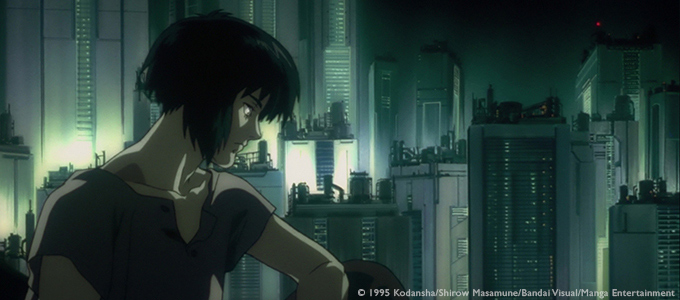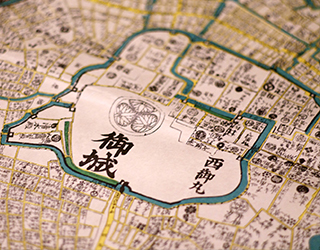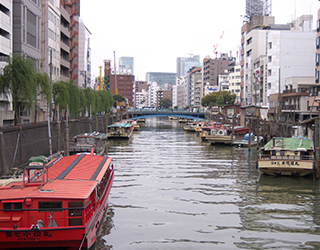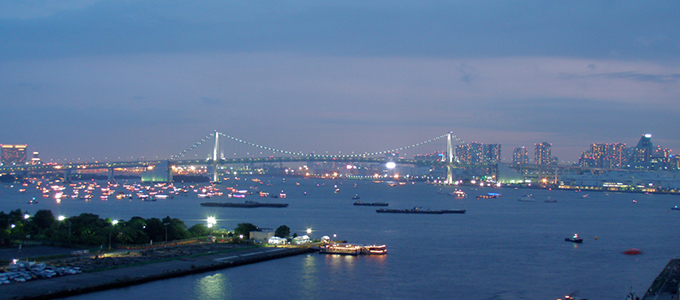
A City Robbed of its Memory
Since the 3.11 earthquake and tsunami disaster, the theories on the relocation of the capital or capital function has become even more popular. Starting with Patlabor 2: The Movie (1993), Director Oshii has explored his own ideas of national security and wars in many of his films. How does someone like him see the centralized capital function of Tokyo?
“People tend to forget that Tokyo is a port city in a bay. A port city opens to the sea for trade, but at the same time introduces many risks. If you want to create a secure capital, it is most logical to put it inland. What I am saying is, are we sure we want to place our country’s entire central system in a location like Tokyo? With that said, I also believe that it isn’t very realistic to divide up the capital’s functions into multiple locations.”
“For example, if we wanted to seize Tokyo, all we would have to do is get one warship in Tokyo Bay and the main system of all 23 districts would fall into its missile range. It could even be a submarine. Maybe a missile wouldn’t even need to be launched.”

“Commodore Perry of the Black Ships knew this, which is why he headed straight for Tokyo Bay, instead of Yokohama. He came on steamboats instead of sailboats, because the Bay will be difficult to enter with only sail winds. The steamboat allowed him to go all the way into his opponent’s territory and easily contain Edo castle and the whole city of Edo in its cannon’s range. Today, this situation remains unchanged.”
But once you land in Tokyo, there is no main military target to overthrow. Even if there is a will to fight, there is nothing to go after. This, in Oshii’s analysis, shows that Tokyo is a rare city that was planned and constructed without war and defense strategies in mind.
“Many capital cities in Europe are actually forts. This comes from their long history of war associated with the creation of a capital. Without capital cities, wars never materialized. Wars used to be just fights that lead to beating each other to death. With the establishment of the capital city, it allowed the conflict to have an aim or a theme. In order to end a war, the capital needed to be seized. That is why the Nazis went for Moscow, and the Allied Forces went for Berlin.”
“Tokyo, on the other hand, was indeed burned to a crisp during World War II, but it never saw heavy fighting on its soil, nor was it completely colonized. I guess the Allied Forces didn’t know how to go about seizing Tokyo. It’s just a city that is flat and goes on forever like an open field. So they chose the method to force Japan’s surrender by burning the whole city of Tokyo down, and dropping the atomic bomb on far-off towns like Hiroshima and Nagasaki.”
“Therefore, Tokyo is a very unique city in this world, incapable of embodying the theme of war. Even the Meiji Restoration saw no bloodshed. Since the fall of the Edo Shogunate, its last feudal regime, Tokyo has never been a battlefield. Only the air raids happened. There wasn’t any special military or defense solutions in response to those airstrikes, and after all was said and done, the air raids were treated like the Great Kanto Earthquake: a natural disaster that suddenly destroyed everything. On the pile of ashes, another defenseless city was built: Tokyo.”

In the 20th Century alone, Tokyo went through two unwanted major reconstructions. Tokyo was damaged to a point beyond recognition and over 200,000 people perished in the Magnitude 7.9 Great Kanto Earthquake in 1923. Within only twenty years, the U.S. air raids took place between the years of 1944 and 1945. The Tokyo we see today is not the result of someone’s precise planning, nor is it a perfect picture. It’s a city that entirely plastered over itself and its memory to enable people to survive.
“If there is one place I could think of that still holds some sentiment or the old memory of Tokyo, also sometimes expressed in films, it is probably the coastline. Somehow, only there, some sense of what makes Tokyo “as it was” is found, and is a basis for a sentimental bond. When the sun is going down, it seems like Tokyo’s oldest memories come into light. But other than that, I can’t think of anywhere else.”
“Basically, the question is, is Tokyo really that attractive? Is it a city that offers a sense of belonging for its people? Every city must offer some sentiment. In Europe, symbolically the towns hold a central plaza with a church. Within that format, people are able to come across their everyday bond to their city, but Tokyo doesn’t have anything like that, you see. There is no such thing as a plaza. Like the Central Park for New Yorkers, there is no place in Tokyo that thoughtfully offers sentiment. The city doesn’t even have a belly button to tie those feelings to.”
“If I exaggerated, I could say that on land Tokyo only has corporate buildings and bars, and the rest is clusters of shopping malls. Therefore, it is on the outskirts or only on the edges, where you will find some of this sentiment of the past. The memory of the inland areas has long been melted away and is unrecognizable. What I am saying is, the only place that preserves this aura is where the surf meets the land. I feel like the twilight hour there, by the sea, tells the true story of the city called Tokyo, and how it came to be.”
(Interview: Manami Iiboshi, Translation: Mika Anami)
